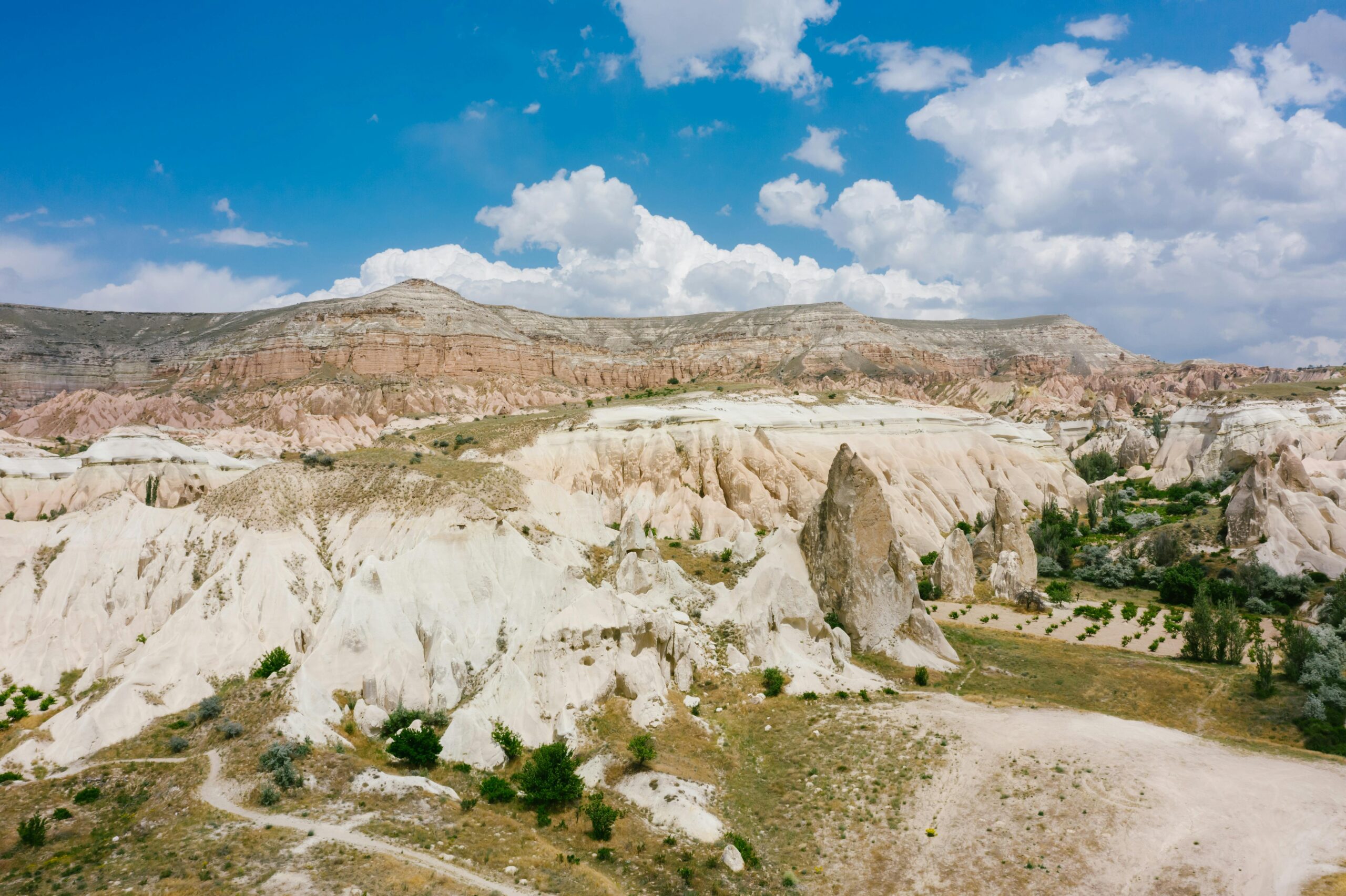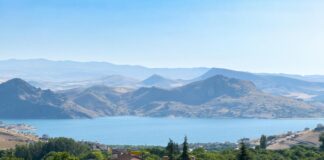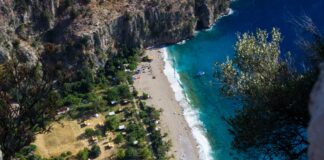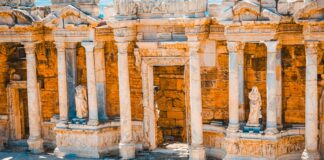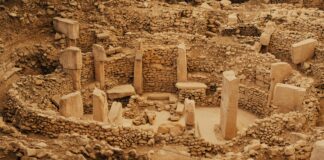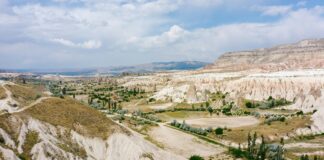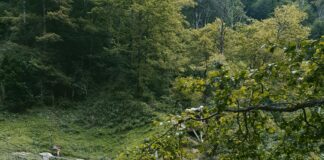Discovering the lava fields of Eastern Turkey is an unforgettable journey that takes you deep into one of nature’s most breathtaking volcanic landscapes. Have you ever wondered what it feels like to walk across ancient, rugged lava terrain, surrounded by surreal rock formations shaped over millennia? This adventure offers not just stunning views but also a unique chance to explore the hidden gems of Eastern Turkey’s volcanic regions rarely touched by mainstream tourism. Whether you’re a passionate traveler or a nature enthusiast, this experience promises excitement, mystery, and awe in equal measure.
Eastern Turkey’s lava fields and volcanic rock formations are a spectacular natural wonder that many travelers overlook. These vast fields of hardened lava flows tell a story of fiery eruptions and the powerful forces beneath the earth’s crust. Imagine trekking through the unique volcanic landscapes of Ağrı Province or wandering near the iconic Mount Ararat, where ancient lava flows have created an otherworldly environment. With its unspoiled natural beauty and dramatic scenery, discovering these lava fields is like stepping into another world—perfect for those seeking a thrilling outdoor adventure off the beaten path.
Are you ready to uncover the secrets of this majestic volcanic terrain and experience the raw power of nature in Eastern Turkey? From the fascinating geology to the rich cultural heritage surrounding these lava fields, this adventure offers much more than just sightseeing. Prepare to be amazed by the stunning volcanic rock formations, hiking trails, and panoramic vistas that await explorers ready to embrace the wild beauty of this extraordinary region.
Exploring Eastern Turkey’s Lava Fields: Top 7 Must-See Geological Wonders
Exploring Eastern Turkey’s Lava Fields: A Journey Like No Other
Eastern Turkey is not the place most travelers first think about when planning a trip, but it holds some of the most stunning and unique geological wonders in the world. If you been looking for an adventure that combines natural beauty, history, and a bit of mystery, then discovering the lava fields of Eastern Turkey should be high on your list. These ancient volcanic landscapes tell stories of earth’s fiery past and offer breathtaking views that you won’t find anywhere else.
Why Eastern Turkey’s Lava Fields Stand Out
The lava fields here are not just ordinary volcanic rocks spread around; they are massive stretches of solidified lava from eruptions that happened thousands to millions years ago. Unlike the popular volcanic sites in other parts of the world, Turkey’s eastern lava fields remain less explored and relatively untouched by mass tourism. This means the experience is raw and authentic, giving visitors a chance to connect with nature in a very special way.
The region’s volcanic activity is linked to the collision of tectonic plates, which created the dramatic topography seen today. The lava flows, cooled and hardened over time, formed a variety of shapes and textures — from smooth basalt columns to jagged rocks and wide plains covered in volcanic debris.
Top 7 Must-See Lava Field Wonders in Eastern Turkey
If you are ready to embark on this geological adventure, here’s a list of the top 7 must-see lava fields and volcanic formations you should not miss:
Nemrut Crater Lake and Surrounding Lava Fields
Located near Tatvan, Nemrut Volcano is one of the most famous volcanic sites in Turkey. The crater lake inside the caldera is stunning but the lava fields around it are equally impressive. The black volcanic rocks contrast beautifully with the blue water and green vegetation.Mount Süphan Lava Flows
Süphan Mountain, the second highest peak in Turkey, was active in the past and left extensive lava fields at its base. The terrain here is rugged but perfect for hiking and photography.Kula Volcanic Park
While technically in western Turkey, Kula is often mentioned because it’s the country’s only UNESCO Global Geopark. It features unique volcanic cones and lava flows similar to those in the east.Hasan Mountain Lava Fields
Hasan Mountain’s lava flows stretch over wide areas around Aksaray. This massive volcanic complex showcases different lava textures and formations formed during several eruptions.Karapınar Lava Field
This area has vast basaltic lava plains and is lesser-known compared to Nemrut or Süphan but equally fascinating for those who seek solitude and natural beauty.Erciyes Volcano Lava Flows
Mount Erciyes near Kayseri is an ancient volcano with old lava fields still visible, surrounded by a popular ski resort, mixing adventure with geological exploration.Mount Ararat Foothills
The foothills of Turkey’s highest mountain also have some volcanic rocks and lava fields, although they are less studied, they offer unique landscapes and cultural significance.
How to Explore These Lava Fields: Practical Tips
Exploring lava fields can be challenging due to rough terrain and sometimes harsh weather. Here are some practical tips for making your trip safer and more enjoyable:
- Wear sturdy hiking boots with good grip because volcanic rocks can be slippery and uneven.
- Carry enough water and food, especially during summer months when the sun can be intense.
- Consider hiring a local guide who knows the area well, as some places lack clear trails or signage.
- Respect the environment; these geological formations are fragile and should not be disturbed or damaged.
- Bring a camera with a wide-angle lens to capture the vastness and unique textures of the lava fields.
- Check weather conditions in advance; Eastern Turkey can have sudden changes, especially in mountainous areas.
Comparing Eastern Turkey’s Lava Fields with Other Volcanic Sites
When you compare Eastern Turkey’s lava fields with more famous volcanic sites like Hawaii, Iceland, or Italy, you notice a few differences:
- Accessibility: Many lava fields in Turkey are remote and less developed for tourism, making them less crowded but harder to reach.
- Age: Some of the lava fields here are older, offering a different look because erosion and vegetation have had more time to change the landscape.
- Cultural Context: These lava fields are often near historical sites and ancient settlements, adding layers of cultural richness to the visit.
- Geological Variety: The types of lava and volcanic rocks found in Eastern Turkey vary greatly because of the complex tectonic setting.
Historical and Cultural Significance
The lava fields are not just natural wonders; they have been part of human history for centuries. Ancient civilizations settled near these volcanic areas, using the fertile soils created by weathered lava for farming. You can find archaeological sites, old caravan
How to Plan an Unforgettable Adventure to the Volcanic Lava Fields of Eastern Turkey
Exploring the volcanic lava fields of Eastern Turkey is an adventure like no other. These vast, rugged landscapes, shaped by ancient volcanic activity, offer unforgettable views and a glimpse into the powerful natural forces that have formed this region over millenniums. If you’re dreaming about a trip that combines nature, history, and a touch of the extraordinary, then discovering the lava fields of Eastern Turkey should be on top of your list. Planning this kind of journey, however, comes with some unique challenges and opportunities you might not expect.
Why Visit the Lava Fields of Eastern Turkey?
Eastern Turkey is home to some of the most dramatic volcanic terrains found anywhere in the world. The lava fields here stretch across provinces like Erzurum, Ağrı, and Van, areas rich with geological wonders and cultural heritage. The volcanic activity that happened thousands of years ago left behind extensive basalt formations and lava plateaus, which now serve as a natural playground for hikers, photographers, and geology enthusiasts.
Some key reasons to visit includes:
- Unique landscapes formed by cooled lava flows
- Diverse flora and fauna adapted to volcanic soil
- Opportunities for hiking, camping, and photography
- Close proximity to historic sites like Mount Ararat and ancient ruins
Unlike more famous volcanic sites worldwide, these lava fields remain relatively under-visited, so you get to experience an untouched and authentic side of Turkey.
Getting There and Getting Around
Reaching Eastern Turkey’s lava fields isn’t always the easiest task. The region is somewhat remote and public transportation options are limited. The nearest major airports are in cities like Erzurum and Van, which are connected by domestic flights from Istanbul and Ankara.
Once you arrive, renting a car is often the best way to explore the area freely. Roads can be rough, and some lava fields are only accessible by 4×4 vehicles. Make sure to prepare for this by checking rental companies carefully and booking in advance during peak seasons.
Local tour guides sometimes offer day trips or multi-day excursions, which can be a great option if you prefer not to drive yourself or want to learn more about the geology and history from a professional.
Where to Stay: Villas and Accommodation Options
While exploring the lava fields, finding comfortable accommodation nearby is important for recharging after long days of adventure. Eastern Turkey offers a variety of lodging types, but villa rentals are becoming increasingly popular for travelers seeking privacy and authenticity.
Here’s a brief overview of what you can expect from villas in this region:
- Traditional stone or adobe houses converted into modern villas
- Spacious rooms with local decor and modern amenities
- Often located in small villages or near natural attractions
- Some villas provide guided tours or local culinary experiences
- Prices vary but generally affordable compared to big city hotels
Staying in a villa not only gives you a cozy base but also lets you experience local culture firsthand. Hosts often share stories about the volcanic landscape and its impact on nearby communities, enriching your visit in unexpected ways.
What to Pack for a Lava Field Adventure
Packing for an adventure in volcanic terrain requires some thought. The lava fields can have sharp rocks and uneven surfaces, so sturdy footwear is a must. Weather in Eastern Turkey can change fast, especially in higher altitudes, so layers of clothing are recommended.
Essentials include:
- Hiking boots with good ankle support
- Sun protection: hat, sunglasses, sunscreen
- Plenty of water and snacks for long walks
- A camera or smartphone with extra batteries
- Basic first-aid kit for minor cuts or scrapes
- GPS or maps, since some areas have limited cellphone coverage
Also, consider bringing binoculars if you want to spot wildlife or distant mountain views.
Historical and Geological Insights
The lava fields are not only beautiful but they tell a story millions years in the making. The volcanic activity in this part of Turkey mainly originated from the tectonic movements of the Eurasian and Arabian plates. Some of the most recent eruptions happened in the Holocene epoch, which means the landscape is still relatively young in geological terms.
Nearby, you can find ancient settlements and archaeological sites that suggest early humans lived in the shadow of these lava formations. These sites provide fascinating context for the natural environment and show how people adapted to living near active volcanoes.
Sample Itinerary for a 3-Day Lava Field Exploration
Day 1: Arrival in Erzurum, transfer to a nearby villa, and a short hike around local lava formations to get familiar with the terrain. Evening dinner with traditional Eastern Turkish cuisine.
Day 2: Full day guided tour of the largest lava field near Mount Ararat, including visits to ancient ruins and geological points of interest. Picnic lunch in the field. Return to villa for rest.
Day 3: Optional morning hike or photography session at sunrise, then visit a nearby village market for souvenirs and local crafts. Travel back to Erzurum or Van for departure.
Comparing Eastern Turkey’s Lava Fields with Other Volcanic Sites
When you compare these
Discover the Breathtaking Beauty of Turkey’s Ancient Lava Formations: A Complete Guide
Discover the Breathtaking Beauty of Turkey’s Ancient Lava Formations: A Complete Guide
If you looking for a travel adventure that is little bit different from the usual beaches and cities, Turkey’s ancient lava formations offer something truly spectacular. The lava fields of Eastern Turkey is a natural wonder that not many travelers know about, but once you visit it, you always remember the stunning landscapes and unique geological history. This guide will take you through the mesmerizing lava fields, their origins, and how you can explore them without missing the best spots.
What Are Turkey’s Ancient Lava Formations?
Turkey’s landscape is very diverse because of its position on several tectonic plates. The ancient lava formations found mainly in Eastern Turkey are remnants of volcanic activity that happened thousands, even millions, years ago. These lava fields were created when molten rock flowed over the surface and solidified into various fascinating shapes and textures.
Unlike typical volcanic mountains you might imagine, these formations spread over vast areas, creating rough terrains, strange rock pillars, and vast plateaus. Some of the lava fields are so extensive that they cover hundreds of square kilometers. They are like giant natural sculptures made by nature’s own hand, telling stories about Earth’s fiery past.
Where to Find the Lava Fields in Eastern Turkey?
The most famous places where you can discover these lava fields include:
- Nemrut Volcano Region: Located near Lake Van, this area is known for its massive lava flows and the famous Nemrut crater lake. The volcanic activity here shaped a dramatic landscape full of rough lava plains and stunning views.
- Mount Süphan: This is an inactive stratovolcano with lava fields surrounding it. The terrain here is perfect for hiking and photography lovers.
- Tendürek Volcano: One of Turkey’s largest volcanoes, Tendürek has extensive lava fields that are relatively untouched by tourism. It’s a great place for those seeking adventure away from crowded paths.
- Karasu Valley: This place has unique lava formations mixed with ancient ruins, giving visitors a taste of both natural and historical wonders.
Why Are These Lava Fields Important?
Understanding Turkey’s lava fields is not just about admiring their beauty. These formations tell us about the tectonic forces that shaped the region and provide clues to Earth’s geological history. Plus, they have influenced local culture and settlement patterns for centuries.
In some areas, the lava rock has been used by locals to build houses, walls, and even ancient fortresses. The porous nature of the volcanic rock also affects the soil and vegetation around, creating a unique ecosystem that differs from other parts of Turkey.
How to Explore the Lava Fields – Tips and Practical Advice
Exploring the lava fields need some preparation because the terrain is often rough and uneven. Here are some tips to help you get the most out of your visit:
- Wear sturdy hiking boots: The rocky surfaces can be sharp and slippery, so good footwear is must.
- Bring plenty of water: Especially in summer, the area can get very hot and dry.
- Use a map or GPS: Some lava fields are vast and easy to get lost in.
- Consider hiring a local guide: They can show you hidden spots and tell you stories about the area’s history and geology.
- Best time to visit: Spring and autumn are ideal because the weather is cooler and the landscape looks greener.
- Photography gear: Don’t forget your camera or smartphone; the lighting during sunrise and sunset makes the formations even more magical.
Comparing Turkey’s Lava Fields to Other Places
Turkey’s lava fields may not be as famous as those in Iceland or Hawaii, but they have their own charm and uniqueness. For example:
| Feature | Turkey’s Lava Fields | Iceland’s Lava Fields | Hawaii’s Lava Fields |
|---|---|---|---|
| Age | Millions of years old | Mostly younger, few thousands | Active, ongoing formations |
| Terrain | Extensive plateaus and plains | Rough, jagged lava flows | Smooth pahoehoe and aa lava |
| Accessibility | Remote, less touristy | Easily accessible in many areas | Popular tourist destinations |
| Vegetation | Sparse, adapted to volcanic soil | Moss and lichens common | Tropical vegetation nearby |
| Cultural Significance | Used in ancient architecture | Mostly natural reserves | Strong cultural and mythological importance |
What Makes This Adventure Unique?
Discovering the lava fields of Eastern Turkey is not only about geology but also the feeling of walking through an ancient world. The silence, the rough ground, and the strange shapes all create an atmosphere of mystery and awe. Plus, because these areas are not overrun by tourists, you often have the place almost to yourself.
If you combine your trip with nearby historical sites or local villages, you get a full experience of Eastern Turkey’s rich heritage and natural beauty. You can visit ancient
Why Eastern Turkey’s Lava Fields Are a Hidden Gem for Nature and Adventure Lovers
Eastern Turkey, known for its rugged mountains and vast steppes, holds a secret that many travelers yet to discover: the stunning lava fields stretching across parts of this region. These strange and beautiful landscapes are not only a feast for the eyes but also a playground for adventure seekers and nature lovers. Why Eastern Turkey’s lava fields are a hidden gem for those who crave nature and excitement is a story waiting to be told, and this article will take you there.
What Are The Lava Fields of Eastern Turkey?
Lava fields, simply put, are large areas covered by solidified lava flows from ancient volcanic eruptions. Eastern Turkey’s lava fields mostly found around Mount Ararat, Tendürek Volcano, and Nemrut Volcano, formed thousands of years ago during intense volcanic activity. These fields are characterized by rough, jagged rocks, black basalt stones, and sometimes strange formations that look alien to the usual landscapes in Turkey.
Interestingly, these lava fields preserve a unique ecosystem. The rocks absorb heat during the day and release it at night, creating microclimates that support rare plants and small animals. Compared to the more forested or green areas in western Turkey, these fields offer a completely different experience for visitors who want to see something out of ordinary.
Why Adventure Lovers Should Head to These Lava Fields
For people who love adventure, the lava fields present opportunities that you can’t find elsewhere in Turkey. Hiking across the uneven surfaces, climbing the volcanic cones, or exploring lava tubes and caves formed by flowing lava are just a few activities. Sometimes the terrain is challenging with sharp volcanic rocks, so it is best to wear strong hiking boots and be prepared for a rough walk.
Here are some adventures you can try:
- Trekking along the lava flows that stretch for kilometers.
- Camping under the open sky surrounded by volcanic rocks.
- Photographing rare geological formations and unique landscapes.
- Exploring ancient volcanic caves and tunnels.
- Bird watching native to this volcanic ecosystem.
One thing that makes these lava fields unique is the contrast between the harsh volcanic landscape and the surprising life it supports. You might spot wildflowers growing in cracks or birds nesting in rock crevices, which makes the adventure more rewarding.
Historical and Geological Context of These Lava Fields
The volcanic activity that created the lava fields started millions of years ago and has shaped much of Eastern Turkey’s geography. Mount Ararat, famous for its biblical associations, is actually a dormant volcano, and around it, smaller volcanoes like Tendürek and Nemrut have erupted in the last several hundred thousand years.
Scientists study these lava fields to understand the volcanic history of the region and how the earth’s crust has changed over time. The layers of lava flows provide clues about the intensity and frequency of eruptions. For travelers, this means walking on landscapes that are not just beautiful, but also a living museum of earth’s geological past.
Comparing Eastern Turkey’s Lava Fields with Other Volcanic Regions
When compared to famous volcanic landscapes like Iceland’s lava fields or Hawaii’s Big Island, Eastern Turkey’s lava fields are less crowded but just as impressive. Iceland’s lava fields are often covered in moss and have a cool climate, while Hawaii’s are often active or recently active with black sand beaches nearby. Eastern Turkey’s lava fields, however, combine ruggedness with historical depth and a unique cultural backdrop.
Here is a quick comparison:
| Feature | Eastern Turkey | Iceland | Hawaii |
|---|---|---|---|
| Climate | Continental, dry summers | Cold, subarctic | Tropical |
| Vegetation | Sparse, unique microclimates | Moss-covered lava | Tropical forests, sparse lava |
| Accessibility | Remote, less touristy | Easily accessible | Tourist-friendly |
| Cultural Significance | Historical, biblical connections | Norse mythology and history | Hawaiian native culture |
| Adventure Activities | Hiking, exploring caves | Hiking, glacier walks | Lava viewing, snorkeling |
Practical Tips for Visiting the Lava Fields
If you decide to explore these incredible lava fields, here are some practical tips to keep your trip safe and enjoyable:
- Best time to visit is late spring to early autumn when the weather is mild.
- Bring plenty of water and snacks since there are few facilities nearby.
- Wear sturdy hiking boots to protect your feet from sharp volcanic rocks.
- Hire a local guide if possible, to learn about the geology and history while staying safe.
- Respect the fragile environment; avoid disturbing plants or animals.
- Prepare for sudden weather changes, especially in mountainous areas.
- Don’t expect many tourists, so bring your camera and enjoy the solitude.
Nearby Attractions to Combine with Your Visit
While the lava fields themselves are the main attraction, the region offers other sites worth exploring. For example, Mount Ararat is a symbol of many legends and provides excellent trekking opportunities. Nearby towns like Doğub
5 Incredible Facts About the Volcanic Lava Fields in Eastern Turkey You Didn’t Know
Exploring the volcanic lava fields in Eastern Turkey is like stepping into another world. You might think these landscapes are just barren rocks and stones, but actually, they hide stories and wonders that many travelers don’t know about. The lava fields here are not only spectacular visually but also tell a tale of the Earth’s fiery past. If you are planning a trip or just curious, this piece will uncover five incredible facts about the volcanic lava fields in Eastern Turkey you probably didn’t know.
5 Incredible Facts About the Volcanic Lava Fields in Eastern Turkey You Didn’t Know
Ancient Volcanic Activity Shaped the Region
Eastern Turkey’s lava fields were formed millions of years ago due to volcanic eruptions. These eruptions left behind vast stretches of basaltic lava that cooled and hardened into unique terrains. The region is part of the larger Armenian Highlands, known for its geological complexity, which includes several dormant and active volcanoes. Unlike some volcanic fields around the world, these lava fields have been relatively untouched by human activity, preserving their raw natural beauty.The Lava Flows Created Unique Habitats
Despite looking inhospitable, these lava fields support a variety of specialized plants and wildlife. The cracks and crevices in the lava provide shelter for small animals and insects, while certain plants adapted to harsh, nutrient-poor soil manages to grow here. This means the lava fields are not just geological wonders but also ecological niches. For example, some endemic species of wildflowers bloom during spring, creating a surprising splash of color against the dark rocks.The Lava Fields Have Cultural Significance
Local communities have long considered these lava fields sacred or mysterious places. Folklore and legends often mention the fiery origins of the land, connecting them to ancient gods and spirits. In some villages, traditional festivals celebrate the volcanoes and their power, reflecting the deep respect and fear people had for the forces that shaped their homeland. This cultural layer adds another dimension to visiting the lava fields, making it not just a nature trip but a journey into local heritage.Volcanic Soil Supports Agriculture Nearby
You might think volcanic lava means lifeless land, but surrounding these lava fields, the soil is actually very fertile. When lava breaks down over time, it releases minerals that enrich the soil, perfect for agriculture. In Eastern Turkey, farmers take advantage of this by growing fruits, vegetables, and even vineyards in the volcanic soil. This contrast between barren lava fields and lush farmland nearby shows nature’s fascinating cycle of destruction and renewal.The Lava Fields Are Great for Adventure Tourism
Travelers who love hiking, photography, and geology find the lava fields perfect for exploration. The rough terrain offers challenging trails and stunning views of the surrounding mountains and plains. Some parts of the lava fields also have caves and rock formations perfect for spelunking and climbing. Unlike crowded tourist spots, these fields offer a peaceful and raw experience, allowing visitors to feel connected to the Earth’s primal forces. Plus, the area’s relative remoteness means you can enjoy starry skies free of light pollution.
Discovering The Lava Fields Of Eastern Turkey: A Breathtaking Adventure
If you want to experience the lava fields yourself, here is what you can expect and how to prepare:
- Where to Go: The most famous lava fields in Eastern Turkey are near Mount Ararat, Lake Van, and the Ağrı Province. These areas have easily accessible spots for visitors.
- Best Time to Visit: Spring and early autumn offer comfortable temperatures and good weather for hiking. Summer can be very hot and winter might cover the fields in snow, making exploration difficult.
- What to Bring: Wear sturdy hiking boots since the rocky terrain can be sharp and uneven. Also, bring water, sun protection, and a camera to capture the incredible landscapes.
- Guided Tours: Local guides are available who know the safest and most interesting routes. They can also share stories about the geology and culture of the area.
Quick Comparison: Eastern Turkey Lava Fields vs Other Famous Lava Fields
| Feature | Eastern Turkey Lava Fields | Hawaii Lava Fields | Iceland Lava Fields |
|---|---|---|---|
| Age | Millions of years old | Mostly recent (last 200 years) | Thousands of years |
| Accessibility | Remote, less touristy | Popular, well-developed tours | Easily accessible |
| Vegetation | Sparse, specialized plants | Tropical plants, forests | Moss and hardy shrubs |
| Cultural Significance | Deep folklore and traditions | Hawaiian mythology | Viking legends |
| Adventure Activities | Hiking, spelunking, photography | Volcano tours, lava viewing | Ice caves, volcano hiking |
Practical Example: A Day Trip Plan to the Lava Fields
- Start early morning from Van city.
Best Hiking Trails Through the Stunning Lava Landscapes of Eastern Turkey
Exploring the rugged and otherworldly landscapes of Eastern Turkey is a journey unlike any other. The region’s dramatic lava fields, shaped by ancient volcanic activity, offers some of the most unique hiking experiences in the world. If you ever dreamed of walking across vast blackened plains of hardened lava and discovering hidden valleys framed by volcanic cones, then the best hiking trails through the stunning lava landscapes of Eastern Turkey should be on your bucket list. This article take you through the highlights of this breathtaking adventure, revealing why these lava fields have attracted explorers, nature lovers, and photographers alike.
Why Eastern Turkey’s Lava Fields Are So Special
Eastern Turkey sits on a geologically active zone where the collision of tectonic plates have created many volcanoes and volcanic formations. The most famous volcanoes in the area are Mount Ararat, Mount Süphan, and Mount Nemrut, but the surrounding regions also hold vast lava flows that date back thousands of years. These lava fields are not just barren wastelands but rich ecosystems where hardy plants and animals adapted to volcanic soil thrive.
The lava rocks create a surreal textured terrain that looks like a frozen river of black glass or rugged basalt columns, depending on the type of volcanic eruption that formed them. Hiking here is not only a physical challenge but also a visual feast. The contrasts of the dark lava, green patches of vegetation, and distant snowy peaks are simply unforgettable.
Top Hiking Trails to Explore the Lava Fields
If you want to experience the lava landscapes in the best way possible, here are some trails you must consider. Each trail varies in difficulty, length, and scenery, so you can choose what suits your adventure spirit.
Mount Süphan Lava Trails
- Duration: 2-3 days
- Difficulty: Moderate to Hard
- Highlights: Hike across vast basaltic lava fields, dense forests, and reach the summit of Mount Süphan for panoramic views.
- Tips: Weather can change quickly, bring warm clothes and good hiking boots.
Nemrut Volcano Lava Loop
- Duration: 1 day
- Difficulty: Easy to Moderate
- Highlights: Explore the lava tubes and smaller volcanic cones around Nemrut volcano. Great for family hikes.
- Tips: Guided tours available, good for learning local geology and history.
Mount Ararat Foothills Trail
- Duration: 3-4 days
- Difficulty: Hard
- Highlights: Trek through ancient lava flows, alpine meadows, and traditional Kurdish villages.
- Tips: Requires permit and local guide, best in summer months.
What To Expect When Hiking in Lava Landscapes
Walking on lava fields is unlike hiking in a forest or mountain trail. The terrain is rough, uneven, and sometimes sharp. Here are some things you should know:
- Footwear is crucial: Thick-soled hiking boots protect your feet from jagged rocks and provide stability.
- Navigation can be tricky: Lava fields often lack clear paths, so GPS or a guide is recommended.
- Weather varies: High altitude and exposed areas mean sudden cold winds or heat in midday.
- Flora and fauna: Look out for hardy plants like wild tulips and small animals such as rock lizards that inhabit volcanic areas.
Historical and Cultural Significance of the Lava Fields
These volcanic regions have been part of human history for millennia. Ancient civilizations lived around these areas, often using volcanic stone for building and tools. Some trails pass near ruins or archaeological sites where you can see relics from Urartian and Armenian cultures.
Moreover, the lava fields have spiritual importance for local communities. For example, Mount Ararat is traditionally considered the landing place of Noah’s Ark, making the region a place of pilgrimage for many.
Comparing Lava Fields With Other Volcanic Regions
Lava landscapes in Eastern Turkey differ from other famous volcanic areas like Hawaii or Iceland. Here’s a quick comparison:
- Turkey vs Hawaii: Turkey’s lava is older and more eroded, forming rugged black plains rather than fresh lava tubes or pahoehoe flows seen in Hawaii.
- Turkey vs Iceland: Iceland’s lava fields are often under glaciers or near active eruptions, whereas Turkey’s lava fields are dry and stable but surrounded by snow-capped peaks.
- Turkey vs Canary Islands: Eastern Turkey’s lava fields cover larger areas and are less touristy, offering a more raw and untouched hiking experience.
Practical Tips for Planning Your Lava Field Adventure
Before you head out, consider these practical tips to make your trip memorable and safe:
- Always carry enough water and snacks; volcanic terrain can drain your energy fast.
- Check weather forecasts and trail conditions. Some areas may be closed in winter or rainy seasons.
- Respect local customs and environment; do not disturb wildlife or pick plants.
- Use a local guide if you
Photography Tips for Capturing the Dramatic Lava Fields of Eastern Turkey
The rugged landscapes of Eastern Turkey offer something truly unique for travelers and photographers alike. Among its most striking natural wonders are the vast lava fields that stretch across the region, creating a dramatic and otherworldly scene. These lava fields, formed from ancient volcanic activity, attract adventurers seeking breathtaking vistas and photographers aiming to capture the raw beauty of nature’s power. If you ever dream about discovering the lava fields of Eastern Turkey or want to improve your photography skills there, this guide will help you get ready for an unforgettable journey.
Discovering the Lava Fields of Eastern Turkey: A Breathtaking Adventure
Eastern Turkey is home to some of the youngest volcanic formations in the country, mainly around the Mount Ararat and Mount Tendürek areas. The lava fields here are remnants of volcanic eruptions that happened thousands of years ago but they look like they formed yesterday. The terrain is rough, covered with hardened black lava rocks, and sometimes dotted with rare vegetation that somehow survived the harsh environment.
These lava fields are not just rocks; they tell stories of Earth’s geological past and the violent processes that shaped the region. The area is especially popular among hikers and photographers who seek landscapes that look like they belong on another planet. Because the lava fields are less crowded than other tourist spots in Turkey, it offers a peaceful atmosphere where you can connect with nature deeply.
If you plan to explore the lava fields, make sure you prepare well. The terrain can be very uneven and sharp, so sturdy hiking boots are a must. Also, the weather can change quickly, so carry layers of clothing. Local guides are available and recommended, as they know the safest paths and the best scenic spots for photography.
Photography Tips for Capturing the Dramatic Lava Fields of Eastern Turkey
Taking photos in the lava fields can be challenging but also incredibly rewarding. The contrast between the dark lava and the bright sky or surrounding landscape creates stunning compositions. Here are some tips to make your shots stand out:
- Use the golden hours: Early morning or late afternoon light enhances the textures and shadows on the lava fields. Shooting during these times gives your photos a warm glow and adds depth.
- Bring a wide-angle lens: The vastness of the lava fields is best captured with a wide-angle lens. It helps you show the scale and drama of the landscape.
- Look for contrast: The black lava against green vegetation or snow-capped mountains creates striking images. Try to include these contrasts in your frame.
- Focus on textures: The rough, cracked surfaces of the lava make interesting close-up shots. Use a macro lens or zoom in to capture the details.
- Tripod is helpful: To take sharp images in low light or for time-lapses, a tripod will keep your camera steady.
- Experiment with different angles: Climb small rocks or find higher ground to shoot from a unique perspective.
- Mind the weather: Clouds and fog can add moodiness to your photos but sometimes block the view. Be patient and adapt your plans according to the conditions.
Historical and Geological Context of Eastern Turkey’s Lava Fields
The lava fields in Eastern Turkey mainly formed from volcanic activity associated with the tectonic movements of the region. The area sits on the convergence zone of the Eurasian, Arabian, and African plates, which causes frequent earthquakes and volcanic eruptions historically. Mount Ararat, which is famous as the supposed resting place of Noah’s Ark, is a dormant volcano surrounded by smaller volcanic cones and lava flows.
Mount Tendürek, another active volcanic area nearby, last erupted roughly 2500 years ago, leaving behind extensive lava fields and volcanic deposits. These lava fields are classified as ‘aa’ and ‘pahoehoe’ types, terms that describe the texture of the hardened lava. ‘Aa’ lava is rough and jagged, while ‘pahoehoe’ is smoother and rope-like.
Because these lava fields are geologically young, they have not yet been completely colonized by plants, which makes the black rocks more visible and adds to the dramatic effect.
Practical Information for Visitors
If you want to visit the lava fields, here is some practical advice that will help you plan your trip:
Where to Go:
- Mount Ararat foothills
- Tendürek Volcano region
- Doğubayazıt district
Best Time to Visit:
- Late spring to early autumn (May to September) for milder weather
- Avoid winter due to snow and cold temperatures
What to Bring:
- Hiking boots
- Sun protection (hat, sunscreen)
- Plenty of water
- Camera gear with extra batteries and memory cards
- Map or GPS device (cell signal may be weak)
Local accommodations range from small guesthouses in surrounding towns to more rustic camping options near the lava fields. Booking a local guide is highly recommended to ensure safety and enrich your experience with historical and geological insights.
Comparing Eastern Turkey’s Lava Fields to Others Worldwide
When you think
What Makes Eastern Turkey’s Lava Fields a Unique Destination for Geotourism?
Eastern Turkey holds a treasure that many travelers have not yet fully discover—the vast lava fields scattered across the region. These natural wonders present a unique opportunity for geotourism, inviting adventurers to explore landscapes shaped by ancient volcanic activity. But what makes Eastern Turkey’s lava fields so special? And why should you consider them as your next travel destination? Let’s dive deep into the rugged, breathtaking world of these geological marvels.
What Are Lava Fields and Why Are They Important?
Lava fields are large expanses of land covered by solidified lava flows. They form when molten rock from volcanic eruptions cools down and hardens over time. Eastern Turkey’s lava fields are particularly interesting because they originate from some of the most significant volcanic activities in the region’s history, dating back thousands of years. This makes them not just scenic spots but also vital records of Earth’s volcanic past.
These lava plains offer:
- Unique rock formations and textures that can’t be found everywhere.
- Insight into volcanic processes that shaped the surrounding landscapes.
- Habitats for specialized plants and animals adapted to the harsh environment.
- Opportunities for scientific research and educational tourism.
Discovering The Lava Fields Of Eastern Turkey: A Breathtaking Adventure
Traveling to these lava fields is not just a sightseeing trip; it’s an adventure that challenges your sense of wonder. The terrain is often rugged, with jagged rocks and uneven surfaces, perfect for hikers and nature lovers who crave something off the beaten path. Some of the most famous lava fields can be found near the towns of Erzurum and Ağrı, where the volcanic history is intertwined with local culture and mythology.
Here is what you can expect during your visit:
- Hiking trails that wind through black basalt rocks and cooled lava flows.
- Panoramic views of the surrounding mountains and steppe.
- Opportunities to spot rare flora and fauna that thrive on the volcanic soil.
- Guided tours explaining the geological background and significance.
- Photo opportunities of dramatic landscapes unlike any other.
Historical Context: Volcanic Activity in Eastern Turkey
Many people doesn’t realize that Eastern Turkey is part of the East Anatolian Volcanic Province, which has been volcanically active for millions of years. Some of the lava fields you see today were formed during eruptions that occurred in the late Pleistocene epoch, roughly 10,000 to 100,000 years ago. The volcanic activity was responsible for shaping many of the region’s natural landmarks, including some nearby mountains and plateaus.
The ongoing geological processes still influence the area, with occasional seismic activity reminding visitors of the earth’s dynamic nature. These historical facts add a layer of depth to your visit, making it not only visually stunning but intellectually enriching too.
Why Eastern Turkey’s Lava Fields Stand Out Compared to Other Destinations
If you compare Eastern Turkey’s lava fields with other famous volcanic landscapes, such as those in Iceland or Hawaii, you will notice some distinct differences:
- Size and Accessibility: Many lava fields here are vast but less crowded, offering a more solitary experience.
- Cultural Integration: The lava fields are often close to villages and towns with rich traditions, providing a mix of natural and cultural tourism.
- Variety of Geological Features: From pahoehoe and a’a lava types to extensive basalt plateaus, the diversity is impressive.
- Climate and Vegetation: Unlike tropical volcanic fields, Eastern Turkey’s lava fields exist in a continental climate, creating a different ecosystem.
Practical Tips for Visiting Eastern Turkey’s Lava Fields
To make the most of your trip, consider these practical advice:
- Best Time to Visit: Spring and autumn are ideal because summer can be very hot, and winters harsh with snow.
- What to Bring: Sturdy hiking boots, sun protection, plenty of water, and a camera.
- Guided Tours: Hiring a local guide is recommended for safety and to gain deeper understanding.
- Accommodation: Nearby towns offer guesthouses and boutique hotels, giving you a comfortable place to rest.
- Respect Nature: Lava fields are fragile environments. Avoid disturbing the rocks or plants.
Quick Overview Table: Eastern Turkey Lava Fields at a Glance
| Feature | Details |
|---|---|
| Location | Eastern Anatolia (Erzurum, Ağrı, Van provinces) |
| Formation Period | Late Pleistocene to Holocene |
| Main Rock Types | Basalt, Andesite |
| Popular Activities | Hiking, photography, geotourism |
| Nearby Attractions | Mount Ararat, Ishak Pasha Palace |
| Accessibility | Moderate – some areas require 4×4 vehicles |
| Accommodation Options | Guesthouses, small hotels in nearby towns |
Embracing the Adventure of a Lifetime
Exploring the lava fields of Eastern Turkey is more than just a visit. It’s a chance to step back in time, walking over the hardened memories of ancient eruptions,
The Science Behind the Formation of Eastern Turkey’s Volcanic Lava Fields Explained
The rugged landscapes of Eastern Turkey holds secrets that many travelers and science enthusiasts alike finds absolutely fascinating. Among these natural wonders are the vast volcanic lava fields that stretch across the region, creating one of the most unique terrains in the world. While some people visit for the adventure and dramatic views, understanding the science behind how these lava fields formed adds a whole new layer of appreciation to the journey. If you ever wonder why Eastern Turkey looks the way it does, or what makes its geology so special, then keep reading to discover the volcanic lava fields of Eastern Turkey like never before.
The Science Behind Eastern Turkey’s Volcanic Lava Fields Formation
Eastern Turkey is located at a tectonic crossroads where several major plates meet — the Arabian, Eurasian, and African plates. The collision and subduction of these plates cause intense geological activity which include earthquakes, mountain building, and volcanic eruptions over millions of years. The volcanic lava fields you see today are the result of this long geological drama.
Volcanoes in this part of Turkey, such as Mount Ararat and Mount Tendürek, have erupted repeatedly throughout history. When magma from deep within the Earth forces its way to the surface, it can flow out as lava that cools and solidifies into rock. Over time, these layers accumulate and spread out, forming the extensive lava plains and fields. Unlike the lush green landscapes in western Turkey, the eastern lava fields are often barren, rocky, and covered with hardened black or red lava rocks.
Some key points about the formation process:
- Magma rises through cracks caused by tectonic shifts in the Earth’s crust.
- Once magma reaches the surface, it cools rapidly, creating diverse lava textures.
- Repeated eruptions build up thick layers of lava rock, sometimes kilometers thick.
- Weathering and erosion slowly shape the lava fields into their current rugged forms.
Discovering The Lava Fields Of Eastern Turkey: A Breathtaking Adventure
Exploring these lava fields is not like your usual hiking or sightseeing trip. The terrain is rough and sometimes deceptive, with sharp rocks and uneven ground. However, the raw beauty and stark contrast to the surrounding landscape makes it an unforgettable experience. Many adventurers come here to see the surreal formations, volcanic cones, and even ancient lava tubes that are hidden beneath the surface.
If you plan a trip to the lava fields, here are some practical things to keep in mind:
- Wear sturdy hiking boots because the lava rocks are very jagged.
- Carry plenty of water and sun protection; the fields offer little shade.
- Consider hiring a local guide who knows the area well and can point out geological highlights.
- Visit during spring or autumn to avoid harsh summer heat or winter snow.
Some of the most famous lava fields you can visit include:
- Mount Tendürek Lava Fields — Known for its spectacular volcanic cones and the unusual “Lava Canyon.”
- Nemrut Caldera — A massive volcanic crater surrounded by lava flows.
- Mount Ararat Foothills — Areas where lava flows have created strange rock formations.
Historical Context and Cultural Significance
Volcanic activity in Eastern Turkey has influenced not only the landscape but also the culture and history of the local peoples. Ancient civilizations settled near these volcanic zones, sometimes using volcanic stones for building their homes or crafting tools. The rich volcanic soil in certain areas also helped agriculture flourish despite the harsh environment.
The mythology surrounding volcanic mountains like Mount Ararat adds mystique to the region. Many stories and legends are tied to the volcanic peaks and lava fields, weaving together geology and folklore. For example, Mount Ararat is famously known as the resting place of Noah’s Ark, adding a spiritual layer to the geological significance.
Comparison: Eastern Turkey’s Lava Fields vs Other Volcanic Regions
To better understand what makes Eastern Turkey special, let’s compare it with other well-known volcanic lava fields:
| Feature | Eastern Turkey Lava Fields | Hawaii Lava Fields | Iceland Lava Fields |
|---|---|---|---|
| Formation Age | Millions of years | Thousands of years | Thousands to millions years |
| Terrain Type | Rugged, rocky plains | Smooth, pahoehoe lava flows | Mixture of rugged and smooth |
| Climate | Continental, dry | Tropical | Subarctic |
| Vegetation | Sparse, desert-like | Lush tropical plants | Moss and sparse shrubs |
| Popular Activities | Hiking, geology sightseeing | Volcano tours, snorkeling | Hot springs, glacier hiking |
As you see, the Eastern Turkey lava fields stand out because of their age, dry climate, and unique geological setting at the meeting point of tectonic plates. This makes them a must-see for travelers interested in geology, adventure, and history.
Practical Examples of Visiting the Lava Fields
Imagine waking up in a small village near
Local Legends and History Surrounding the Mysterious Lava Fields of Eastern Turkey
The rugged landscapes of Eastern Turkey hold many secrets, but none are quite as captivating as the mysterious lava fields that stretch across the region. These ancient formations, born from volcanic eruptions thousands of years ago, tell stories not only of geological wonder but also of local legends and history that have been passed down generations. Exploring these lava fields is like stepping into a world where nature and myth collide, offering travelers an unforgettable adventure.
The Formation of Eastern Turkey’s Lava Fields
Eastern Turkey is part of a geologically active area, where tectonic movements created several volcanoes. Over time, eruptions from these volcanoes released molten lava that cooled and solidified into vast fields of black rock. The most famous among these is the Nemrut Lava Field near Lake Van, which covers hundreds of square kilometers. These lava fields are not just barren lands; they are complex ecosystems with unique flora and fauna adapted to the volcanic soil.
The age of the lava fields varies, but many date back several thousand years, making them one of the oldest volcanic landscapes in the region. The terrain is often rough and uneven, with jagged rocks and deep fissures, which make exploring it both thrilling and challenging.
Local Legends and Mythical Stories
The people living near the lava fields have long created stories to explain these strange landscapes. One popular legend talks about a great fire dragon that once lived beneath the earth, breathing lava and smoke, shaping the land as it roamed. Another tale tells about a heroic warrior who fought against this fiery beast, eventually turning the molten lava into stone to protect the villages nearby.
These stories aren’t just folklore; they reflect the community’s respect and fear for the natural forces that shaped their homeland. Many locals still believe the lava fields are sacred places, and some visit them for spiritual reasons or traditional ceremonies.
Why Discovering the Lava Fields Is a Breathtaking Adventure
Visiting the lava fields of Eastern Turkey is not like typical sightseeing. The experience is raw, wild, and filled with surprises. Here are some reasons why travelers find it so breathtaking:
- Dramatic landscapes that look almost otherworldly
- Opportunities for hiking and exploration on rugged terrain
- Stunning views of surrounding mountains and Lake Van
- Unique geological formations like lava tubes and basalt columns
- Chance to witness rare plants and animals adapted to volcanic soil
Besides the natural beauty, the solitude of the lava fields offers a peaceful retreat from crowded tourist spots. Many visitors say the silence and vastness give them a deep sense of connection to the earth.
Practical Tips for Travelers
If you are planning to explore these lava fields, there are few things you should keep in mind:
- Wear sturdy hiking boots because the lava rocks can be sharp and slippery.
- Bring plenty of water and snacks since there are no facilities nearby.
- Hire a local guide who knows the terrain and can share stories and history.
- Visit during spring or autumn to avoid extreme temperatures.
- Respect the natural environment and local customs, especially if you encounter sacred sites.
It’s also a good idea to combine your lava field trip with visits to nearby attractions like the ancient city of Van, its historic castle, and the beautiful Akdamar Island.
Comparing Eastern Turkey’s Lava Fields with Other Famous Volcanic Areas
Many people may be familiar with volcanic landscapes like those in Iceland or Hawaii, but Eastern Turkey’s lava fields have their own unique charm and history:
| Feature | Eastern Turkey | Iceland | Hawaii |
|---|---|---|---|
| Age of lava fields | Thousands of years old | Relatively young (hundreds years) | Continuously active |
| Landscape type | Jagged, rugged, basalt fields | Smooth lava flows and craters | Volcanic cones and black sand beaches |
| Cultural significance | Deep local legends and myths | Mainly geological interest | Strong native Hawaiian traditions |
| Accessibility | Remote, less touristy | Well-developed tourist routes | Popular with many visitors |
This comparison shows that while Eastern Turkey might be less known, it offers a unique blend of natural beauty and cultural heritage that makes it worth discovering.
Historical Context of Volcanic Activity in the Region
Volcanic activity around Lake Van and the surrounding areas has shaped not only the landscape but also human settlement patterns. Ancient civilizations, like the Urartians, lived near these volcanic regions and used the terrain for defense and resources. The black volcanic stone was often quarried to build fortresses and temples.
Over centuries, the lava fields also influenced agriculture since volcanic soil is rich in minerals, though farming directly on the lava is difficult. This mix of natural hazard and benefit has defined how communities adapted and thrived in Eastern Turkey.
Exploring the lava fields is like opening a window into the past, where nature’s power and human history meet in fascinating ways.
What to Expect When Visiting
Visitors to the lava fields often
Conclusion
Exploring the lava fields of Eastern Turkey offers a unique glimpse into the region’s powerful geological history and stunning natural beauty. From vast blackened landscapes formed by ancient volcanic eruptions to the rare flora and fauna that have adapted to these harsh conditions, these fields are a testament to nature’s resilience and transformative power. Visitors can immerse themselves in a variety of outdoor activities, including hiking and photography, while gaining a deeper appreciation for the dynamic forces that have shaped this captivating terrain. Whether you are a geology enthusiast, an adventure seeker, or simply someone looking to connect with an extraordinary environment, Eastern Turkey’s lava fields promise an unforgettable experience. As awareness grows about these remarkable landscapes, it is crucial to support sustainable tourism efforts that protect their delicate ecosystems. Plan your journey today and witness firsthand the raw beauty and enduring spirit of Turkey’s volcanic heartland.
